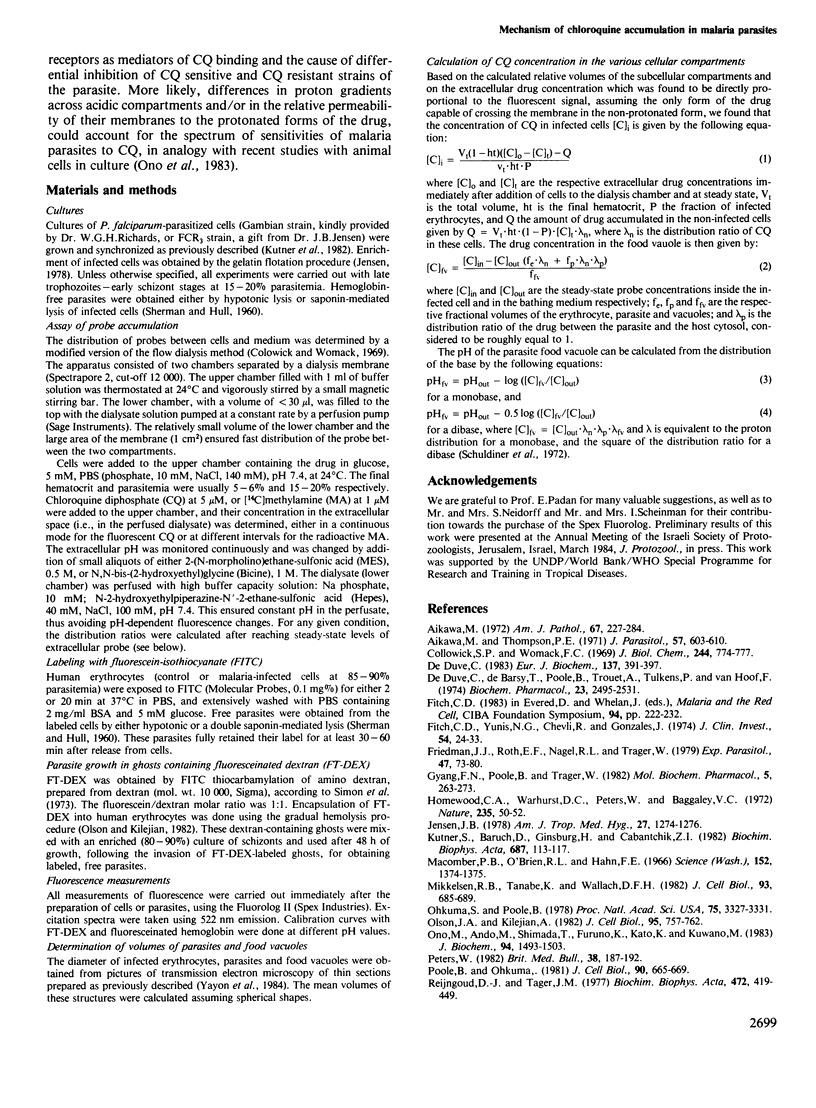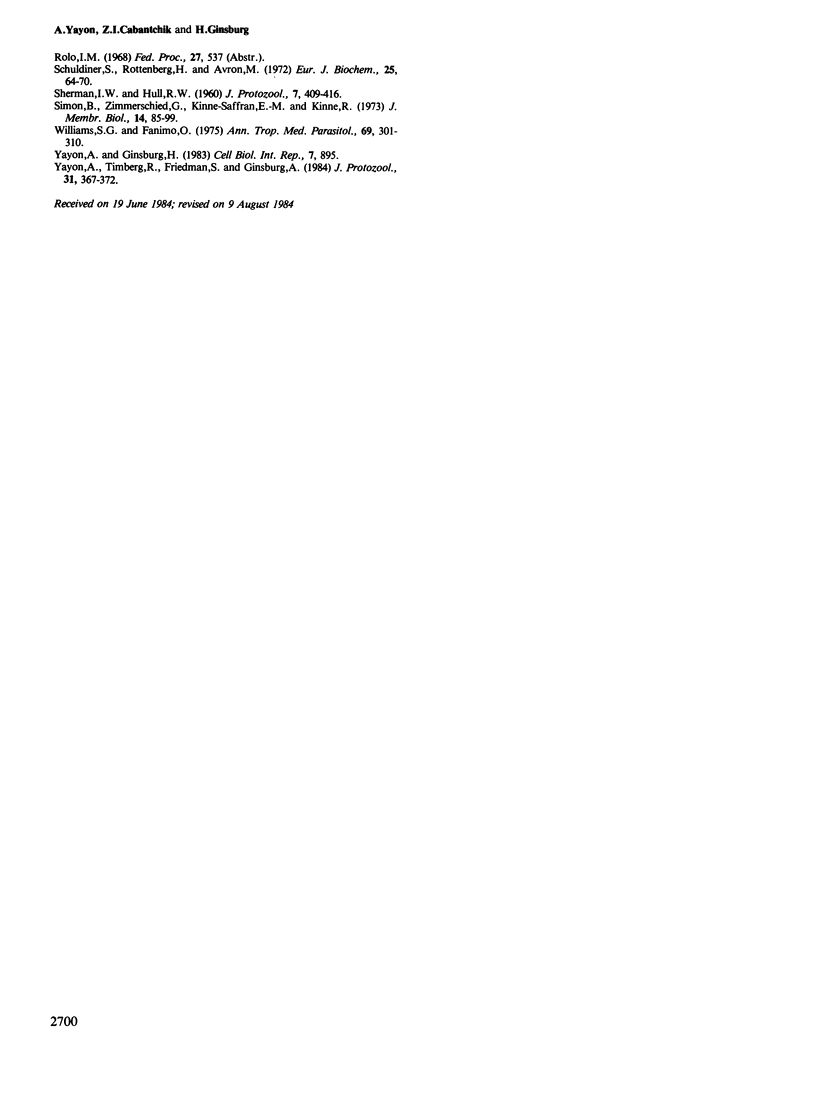Abstract
Chloroquine (CQ), the most widely used antimalarial drug, is an acidotropic agent (De Duve, 1983) which accumulates to high levels in malaria-infected erythrocytes. A possible site of accumulation of the drug, the parasite's food vacuole, has been implicated in the mode of action of CQ. We have defined the various compartments of Plasmodium falciparum-parasitized human erythrocytes in terms of their pH and capacity to accumulate bases. The host cell and the parasite cytosols were differentially labeled in situ with pH-sensitive fluorescein, and the parasite food vacuole was revealed by targeting fluoresceinated dextran via endocytosis. The pH of the various compartments obtained from fluorescence excitation spectra were 6.9 for the cytosol of normal and infected erythrocytes and 5.2 for the parasite food vacuole. Determination of CQ and methylamine accumulation in infected erythrocytes, in conjunction with morphometric determination of the relative sizes of the various cellular compartments, provided an independent assessment of the vacuolar pH, yielding a value of 5.0-5.2. Perturbation of the proton gradient, either by lowering extracellular pH or by alkalinization of the food vacuole with NH4Cl or monensin, resulted in a concomitant and reversible decrease in accumulation of the probe. We conclude that drug accumulation in malaria-infected erythrocytes can be fully accounted for by the steady-state proton gradients across the barriers delineating the various cellular compartments and the acidotropic properties of the drug.
Full text
PDF





Selected References
These references are in PubMed. This may not be the complete list of references from this article.
- Aikawa M. High-resolution autoradiography of malarial parasites treated with 3 H-chloroquine. Am J Pathol. 1972 May;67(2):277–284. [PMC free article] [PubMed] [Google Scholar]
- Aikawa M., Thompson P. E. Localization of acid phosphatase activity in Plasmodium berghei and P. gallinaceum: an electron microscopic observation. J Parasitol. 1971 Jun;57(3):603–610. [PubMed] [Google Scholar]
- Colowick S. P., Womack F. C. Binding of diffusible molecules by macromolecules: rapid measurement by rate of dialysis. J Biol Chem. 1969 Feb 25;244(4):774–777. [PubMed] [Google Scholar]
- Fitch C. D. Mode of action of antimalarial drugs. Ciba Found Symp. 1983;94:222–232. [PubMed] [Google Scholar]
- Fitch C. D., Yunis N. G., Chevli R., Gonzalez Y. High-affinity accumulation of chloroquine by mouse erythrocytes infected with Plasmodium berghei. J Clin Invest. 1974 Jul;54(1):24–33. doi: 10.1172/JCI107747. [DOI] [PMC free article] [PubMed] [Google Scholar]
- Friedman M. J., Roth E. F., Nagel R. L., Trager W. Plasmodium falciparum: physiological interactions with the human sickle cell. Exp Parasitol. 1979 Feb;47(1):73–80. doi: 10.1016/0014-4894(79)90009-2. [DOI] [PubMed] [Google Scholar]
- Gyang F. N., Poole B., Trager W. Peptidases from Plasmodium falciparum cultured in vitro. Mol Biochem Parasitol. 1982 Apr;5(4):263–273. doi: 10.1016/0166-6851(82)90034-2. [DOI] [PubMed] [Google Scholar]
- Homewood C. A., Warhurst D. C., Peters W., Baggaley V. C. Lysosomes, pH and the anti-malarial action of chloroquine. Nature. 1972 Jan 7;235(5332):50–52. doi: 10.1038/235050a0. [DOI] [PubMed] [Google Scholar]
- Jensen J. B. Concentration from continuous culture of erythrocytes infected with trophozoites and schizonts of Plasmodium falciparum. Am J Trop Med Hyg. 1978 Nov;27(6):1274–1276. doi: 10.4269/ajtmh.1978.27.1274. [DOI] [PubMed] [Google Scholar]
- Kutner S., Baruch D., Ginsburg H., Cabantchik Z. I. Alterations in membrane permeability of malaria-infected human erythrocytes are related to the growth stage of the parasite. Biochim Biophys Acta. 1982 Apr 23;687(1):113–117. doi: 10.1016/0005-2736(82)90178-x. [DOI] [PubMed] [Google Scholar]
- Macomber P. B., O'Brien R. L., Hahn F. E. Chloroquine: physiological basis of drug resistance in Plasmodium berghei. Science. 1966 Jun 3;152(3727):1374–1375. doi: 10.1126/science.152.3727.1374. [DOI] [PubMed] [Google Scholar]
- Mikkelsen R. B., Tanabe K., Wallach D. F. Membrane potential of Plasmodium-infected erythrocytes. J Cell Biol. 1982 Jun;93(3):685–689. doi: 10.1083/jcb.93.3.685. [DOI] [PMC free article] [PubMed] [Google Scholar]
- Ohkuma S., Poole B. Fluorescence probe measurement of the intralysosomal pH in living cells and the perturbation of pH by various agents. Proc Natl Acad Sci U S A. 1978 Jul;75(7):3327–3331. doi: 10.1073/pnas.75.7.3327. [DOI] [PMC free article] [PubMed] [Google Scholar]
- Olson J. A., Kilejian A. Involvement of spectrin and ATP in infection of resealed erythrocyte ghosts by the human malarial parasite, Plasmodium falciparum. J Cell Biol. 1982 Dec;95(3):757–762. doi: 10.1083/jcb.95.3.757. [DOI] [PMC free article] [PubMed] [Google Scholar]
- Ono M., Ando M., Shimada T., Furuno K., Kato K., Kuwano M. Isolation of chloroquine-resistant Chinese hamster V79 cell variants that are also resistant to ammonium chloride. J Biochem. 1983 Nov;94(5):1493–1503. [PubMed] [Google Scholar]
- Peters W. Antimalarial drug resistance: an increasing problem. Br Med Bull. 1982 May;38(2):187–192. doi: 10.1093/oxfordjournals.bmb.a071757. [DOI] [PubMed] [Google Scholar]
- Poole B., Ohkuma S. Effect of weak bases on the intralysosomal pH in mouse peritoneal macrophages. J Cell Biol. 1981 Sep;90(3):665–669. doi: 10.1083/jcb.90.3.665. [DOI] [PMC free article] [PubMed] [Google Scholar]
- Reijngoud D. J., Tager J. M. The permeability properties of the lysosomal membrane. Biochim Biophys Acta. 1977 Nov 14;472(3-4):419–449. doi: 10.1016/0304-4157(77)90005-3. [DOI] [PubMed] [Google Scholar]
- Schuldiner S., Rottenberg H., Avron M. Determination of pH in chloroplasts. 2. Fluorescent amines as a probe for the determination of pH in chloroplasts. Eur J Biochem. 1972 Jan 31;25(1):64–70. doi: 10.1111/j.1432-1033.1972.tb01667.x. [DOI] [PubMed] [Google Scholar]
- Simon B., Zimmerschied G., Kinne-Saffran E. M., Kinne R. Properties of a synthetic plasma membrane marker: fluorescent-mercury-dextran. J Membr Biol. 1973 Dec 6;14(1):85–99. doi: 10.1007/BF01868071. [DOI] [PubMed] [Google Scholar]
- Williams S. G., Fanimo O. Malaria studies in vitro. IV: Chloroquine resistance and the intracellular pH of erythrocytes parasitised with Plasmodium berghei. Ann Trop Med Parasitol. 1975 Sep;69(3):301–309. [PubMed] [Google Scholar]
- Yayon A., Ginsburg H. Chloroquine inhibits the degradation of endocytic vesicles in human malaria parasites. Cell Biol Int Rep. 1983 Nov;7(11):895–895. doi: 10.1016/0309-1651(83)90207-2. [DOI] [PubMed] [Google Scholar]
- Yayon A., Timberg R., Friedman S., Ginsburg H. Effects of chloroquine on the feeding mechanism of the intraerythrocytic human malarial parasite Plasmodium falciparum. J Protozool. 1984 Aug;31(3):367–372. doi: 10.1111/j.1550-7408.1984.tb02981.x. [DOI] [PubMed] [Google Scholar]
- de Duve C. Lysosomes revisited. Eur J Biochem. 1983 Dec 15;137(3):391–397. doi: 10.1111/j.1432-1033.1983.tb07841.x. [DOI] [PubMed] [Google Scholar]
- de Duve C., de Barsy T., Poole B., Trouet A., Tulkens P., Van Hoof F. Commentary. Lysosomotropic agents. Biochem Pharmacol. 1974 Sep 15;23(18):2495–2531. doi: 10.1016/0006-2952(74)90174-9. [DOI] [PubMed] [Google Scholar]


